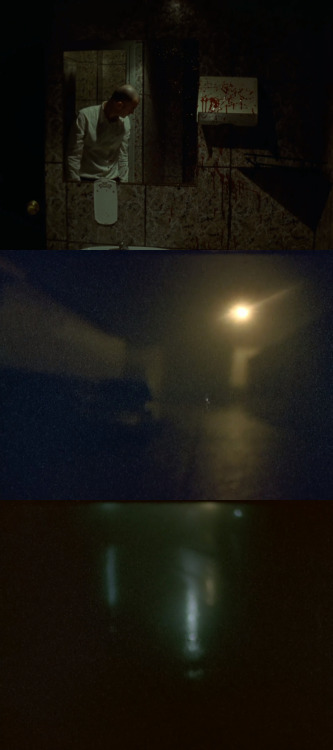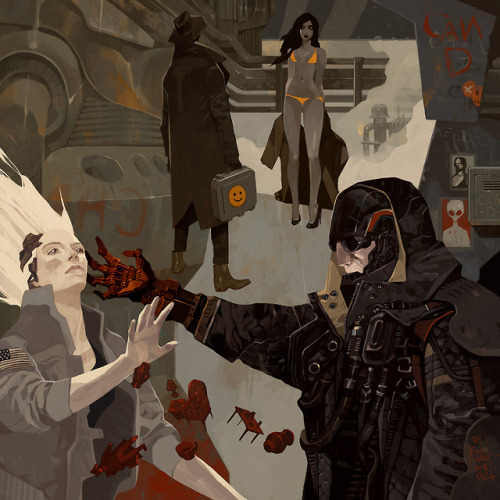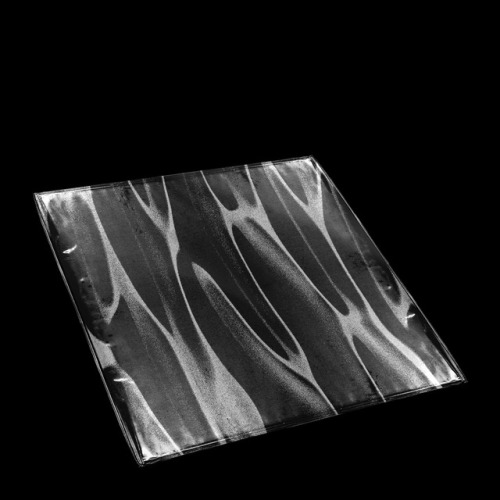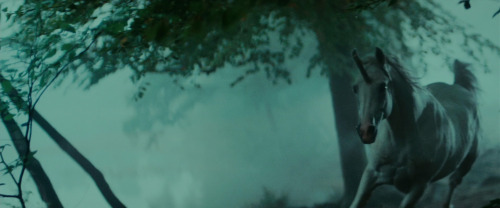#philip k dick
The Doors of Perception, Aldous Huxley
Play It As It Lays, Joan Didion
The Three Stigmata of Palmer Eldritch, Philip K. Dick
The Silver Locusts, Ray Bradbury
Post link

Minority Report (2002)
Lag Time: 14 years
Dir. Steven Spielberg
Starring: Tom Cruise, Colin Farrell, Samantha Morton, Max von Sydow
Here we have one of Steven Spielberg’s most unique but ignored films from his 2000s filmography: Minority Report. I explore what about it makes this film underrated and what weaknesses have buried it outside our cultural memory.
Spielberg’s 2002 thriller is very clearly in the company of other film adaptations of the works of story-teller Philip K. Dick. A coupling of futuristic vision and plot-twisting action, Minority Report represents the famed author well as it places itself among the higher-quality adaptations. And yet, despite very positive reviews, this film does not attract very fond retrospection. It remains frequently overlooked.
We see elements compete throughout the film. The story, taking place in 2054, is set-up quite well in the exposition. We learn that a special police force called “Pre-crime” has been channeling the clairvoyant powers of three gifted “pre-cogs” to catch murderers before they commit their crimes. While certain mechanics of the plot are directly introduced, there are many moments that reveal Spielberg’s knack for handling details, for setting up characters and situations without drawing attention to the fact that exposition is happening. One thing that makes this director so great is how slyly he wields Chekhov’s gun. The Pre-crime system is set-up incredibly well with an engaging opening scene and rising action. These first forty-five minutes are, however, weighed down by special effects that do not quite seem ready for this film’s demands, and by editing that is not quite fast enough to support action which is nevertheless intriguing and original.
The middle of this movie is its most puzzling part. While in the interest of world-building and resisting the temptation to fill that world with two-dimensional stock characters, the second forty-five minutes are characterized by a weirdness that seems more or less arbitrary. There are moments in the scenes with the botanist (the “inventor” of Pre-crime) and the surgeon (with an interesting but distracting backstory) which wind this movie a little less tightly than other Spielberg works. The vines that attack protagonist John Anderton and the subsequent antidote scene are an instance of the extraneous world-building detours that do not really fit the tone or the plot and only distract the pace. I believe these weird moments and characters are there for that pace though. In distracting the flow, they make up for what would likely be an under-stimulating and slow-paced middle segment. But that rescue job is achieved by bizarre and burdensome intrigue alone.
The plot takes us to events of foreseen homicide, and we seem to be gearing up for an unsatisfying conclusion. A climax nears but it seems contrived and premature, with an unimaginative dramatic theme about thwarting destiny. Perhaps because of what came before, I was expected to be let down as I expected the movie to come its end. But then the plot twists. And it does so quite well. I fell for some story-telling sleight-of-hand, and so the twist was truly unexpected. What evolved in the final act was the most entertaining and successful part of the whole film as plot elements which before seemed under-cooked began to evolve. The story’s concept is engaged to the plot’s extreme benefit in what is really some excellent screenwriting work by Scott Frank and Jon Cohen. The film’s mystery is at its most rich in these final forty-five minutes. They redeem the film, if I do say so myself, and make it well worth the watch.
The screenwriting is not all this well written. There are a few weak lines which mainly serve as your basic dramatic padding. And there are too many puns revolving around eyes. While not a fault of the writers, the screenplay does not always seem to match well with the direction by Spielberg and the editing by Michael Kahn, most evident to me in the scenes in the greenhouse and the surgeon’s apartment. The production gives these scenes (and more) a faster pace than the writing warranted. These issues of pacing, if it is not yet apparent, seem to be the most impressionable issues of the film as I look back on it.
There are moments of the score by John Williams which really standout as mature and individual in his ouerve. At other moments, you can hear that he was rushed into this score from his work on Attack of the Clones. They are stylistic siblings, genetically linked. The design of this film also stands out. The movie, if anything, is the realization of a great effort of cinematic future-building. Beyond the production design, the visual style itself is inspired yet sometimes gets in the way of the film’s clarity with Kamiński’s overlighting and desaturating with the film.
Each of these elements - from writing to visuals and more - supports the overall film well but also each have their moments of weakness which work to unwind the film. In short, this film has taken the back-seat in Spielberg’s filmography, likely due to its inconsistency and an occasional strangeness which can be off-putting for viewers. The weaker scenes reveal the dissonance between art and action. But there are elements which are strange in just the right ways, and where the art and the action merge is the realm of pure mystery and cinematic tension, the latter of which for sure is right in Spielberg’s wheelhouse.
Worth a watch? Definitely. Worth remembering? I can see why it hasn’t been. Worth reviving? I think so. Whether the new television show does that, I have yet to see. But looking back to the film is certainly a fair use of anyone’s time.
Monday Morning Links!
* Paradoxa 32 has a cover.
* Boys don’t read enough.
* The era of high fertility is ending. Every child on their own trampoline. Police-Free Childhoods. The Seismic Generational Shift in Worldview: Millennials Seek a Nation Without God, Bible and Churches.
* Selfies, Surgeries And Self-Loathing: Inside The Facetune Epidemic.
* The Bullshit Jobs Boom.
* The empty brain. Your brain does not…

RIP,Vangelis(1943-2022)

Short animation_sf numbers
Who is waiting for Blade Runner 2049 ? :D
I’m counting down the days… <3
Io sono vivo, voi siete morti
Tra buona parte dei miei colleghi e me va ingigantendosi il già grande divario che ci separa. Completamente devoti alla figura del gran capo loro, pienamente razionale e disilluso io, viaggiamo su binari differenti che hanno finito con il collocarci a distanza siderale. Riconosco in pieno i tanti meriti (prevalentemente in ambito commerciale) di colui che ci guida e dei suoi più stretti collaboratori, ne ammiro il dinamismo contagioso, ne elogio la visione imprenditoriale che ha portato lui e l'azienda ad aumentare mostruosamente il fatturato. Onore al merito, sempre e comunque. Però…eh, ci sono dei però. La gestione del personale si potrebbe piuttosto definire “spremitura” del personale, soprattutto per chi occupa ruoli di minor rilievo ma non meno importanti. Alle richieste di costoro risponde ignorandole quando va bene o facendo spallucce. La considerazione che ha di alcuni reparti è alta, nei confronti di altri c'è un più che evidente fastidio, ad una certa voglia di migliorare le condizioni presso alcune strutture si contrappone il disinteresse nei confronti di altre. Ed è palese, la cosa. Voglio dire, è davvero chiaro come il sole come ci siano figli e figliastri, in azienda, e che a far le spese di questo suo atteggiamento siano i “piani bassi”, operai in primis. Eppure sono rimasto uno dei pochi a vedere le cose come stanno, quindi a distribuire elogi quando dovuti ma critiche quando meritate. È come se gli estimatori del capo si foderassero a tal punto gli occhi da essere proprio incapaci di vedere situazioni lampanti e quand'anche sono io a far notare qualche paurosa contraddizione fra il loro giudizio acritico e la banale realtà, mi guardano stupiti/e e scuotono la testa dicendo “ma che strano”. Già, che strano vedervi completamente asserviti alla causa, che strano che non riusciate proprio a notare le incongruenze fra quanto accade quotidianamente e l'ideale del leader illuminato che vi siete creati. Che strano per me, che lavoro per lo stipendio, vedere voi vivere in funzione di un'azienda che, statene certi, in caso di necessità agirà come qualsiasi altra azienda (cosa già avvenuta in tempi diversi). In un mare di cieca idolatria nei confronti di una persona accentratrice e vanitosa, mi sento ormai una sorta di sopravvissuto che di questa Grande Famiglia è il solo a vedere l'ipocrisia. Come scriveva qualcuno, io sono vivo, voi siete morti.

We get enough people at book fairs, sellers included, asking us what Speculative Fiction is that we thought an explanation was merited.
Note: I have no intention of arguing the case that science fiction and fantasy are as much skilled works of art as regular literature; that argument has been covered enough times and it bores me. Time determines what is art not genre.
As the term suggests speculative fiction is fiction that involves some element of speculation. Of course, one can argue that all fiction is speculative insofar as it speculates what could happen if various elements of a story were combined. Yet we feel that this term is descriptive enough to encompass the type of literature we want to categorise. First, a word about genre
Book genre is of limited use and is often more harmful than good. If you went into a bookshop and asked for literature, you’d be taken to the fiction section. If you said that you were looking for any Darwinian literature you’d be sent to the science section. At some point it was determined that literature suggested artistic merit. Yet we also use it to cover a particular grouping of written works. The point is that classifying the written word is a little futile as common usage will usually dictate what that classification envelops, and common usage is of course open to interpretation. Genre does however allow boundaries to be set for marketing purposes; if a reader enjoyed a number of books in a certain genre then there’s a reasonable chance they’d enjoy other books in the same genre. From a critical perspective, understanding genre helps align a work of literature with one’s expectations; certain tropes and mechanisms are, to some extent, more acceptable in one genre than another.
Now, this element of speculation. The speculation in speculative fiction isn’t concerned solely with speculation over how various story elements might interact, but speculation over the fabric of those elements. A work of speculative fiction takes one or more elements of an otherwise perfectly possible story and speculates as to what would happen if that element existed outside of current understanding or experience. Essentially, it’s writing about things that aren’t currently possible. The Road by Cormac McCarthy is a father-son story of survival, nearly everything is contemporaneously possible, except one thing the setting of the story is plausible future.
When you pick up an Agatha Christie, a Jane Austen or a Graham Greene, regardless of how the story unfurls, and how perhaps unlikely the story, it’s always within the realm of possibility (poor writing and deus ex machina aside). Yet a Philip K. Dick, a Tolkien or a Stephen King will always seem impossible, given current understanding.
The word current is key, to allow inclusion of scientific speculation. A seminal work like Kim Stanley Robinson’s Red Mars has a lot of the science in place to explain how the colonisation of Mars might / could take place (I assume the science is correct; it doesn’t matter to me personally but I know a lot of readers are particular in this area). The speculation is on how plausible, but currently theoretical, scientific and technological advances might solve a problem.
There is a slight grey area where such scientific knowledge and its technical implementation exists and is currently possible and a good story has been written about it. Imagine a book about travelling to the moon written in 1969. Imagine it’s not an adventure, it explores personal relationships between the characters and their heroic journey. For someone unfamiliar with planned space travel such a book would seem like science fiction, yet it was of course entirely possible in 1969. I personally wouldn’t classify such a work as speculative fiction as it doesn’t fit the definition, but I’d certainly class it as science fiction if I were to market it as it would fit the bill for many readers. Similarly a book like Psycho, it’s a work of horror but there’s no supernatural element and it’s plausible and possible given current understanding.
For books like The Hobbit orCarriethecurrent part of the definition becomes less important; Middle-Earth neither has nor probably will exist, neither will telekinesis. Of course, as science progresses some things that are currently implausible will be come plausible, if not possible. Space travel being a great example; progress is constantly being made.
Speculative fiction is also an umbrella term so includes the majority of works in the fantasy, science fiction and horror genres, also smaller genres such as magic realism, weird fiction and more classical genres such as mythology, fairy tales and folklore. Many people break speculative fiction into two categories though: fantasy and science fiction, the former being implausible the latter being plausible (in simplistic terms). This is helpful for those interested in having some sort of technical foundation upon which to build their speculation, and those who aren’t.
When one thinks of science fiction, one thinks back to the 1930’s and the Gernsback era, perhaps earlier to Wells and Verne. One might even cite Frankenstein. When one thinks of fantasy one thinks of Tolkien, perhaps Victorian / Edwardian ghost stories, Dracula, perhaps Frankenstein. It seems comfortable to think of these things as modern endeavours. Anything earlier often falls under the general category of literature (in the non-speculative fiction sense). Take More’s Utopia,you’d find that under literature or classics, not under fantasy. Similarly Gulliver’s Travels. Again, this is just marketing; there’s no reason why Gulliver’s Travels should not be shelved next to Lord of the Rings other than to meet a reader’s expectation.
At Hyraxia Books we like to think of certain classic works not simply as works that have contributed to the literary canon, but also as works that have contributed to the speculative fiction canon. For us, Aesop’s Fables,Paradise Lost, The Divine Comedy, Otranto, A Midsummer Night’s Dream, The Iliad, The Prose Edda, Beowulf and the Epic of Gilgamesh are not simply classics, but also speculative fiction classics. We don’t like to think of the genre starting in the last two hundred years, we like to think of literature (in the non-speculative fiction sense) having branched off from the speculative rather than the other way round. We like to see how that story has played out over the millennia.
That is how we define speculative fiction for the basis of our stock. Of course, we stock other items too, many of which we are very fond of.
A new collector got in touch recently to ask our opinion on an inscribed book. He was concerned because the book was signed to someone else. I pointed out the various merits and flaws with the different types of signatures. It seemed apt thereafter to share this on our blog.
Signed or Inscribed
This is an oft mentioned argument. A signed book is one where the author has scrawled nothing but their name on the book. An inscribed book on the other hand usually carries the name of the recipient in the author’s hand [often an inscribed book will just carry a greeting without a name]. Of late there has been debate about the various merits of the two types of signature. I’ll outline below the merits of each.

A signed book

An inscribed book
An inscribed book is usually signed to someone else and carries their name. People often find this less than desirable because every time the owner examines the signature they are reminded that the book isn’t signed to them personally. This is just a facade of course, as a book purchased signed or inscribed has no connection with the purchaser anyway. But it is easy to see how the anonymous signature could be preferred. That being said, here at Hyraxia, we believe the more ink on the page the better. If a collector looks to buy only books signed without an inscription then they are often dismissing inscriptions that could have merit of their own; even a few brief words can give a deep insight into the author’s manner and make an ordinary book something special.

A book inscribed without a name.
Of greater significance is where an author signs without inscription by default. In these cases, such as with Graham Greene, an inscription is preferred. These signatures are both scarcer and more collectable as Greene generally inscribed books to people he knew.
The final point to consider is forgeries. A forger is less likely to risk exposure by writing an essay on the title page. That said, an expert forger will likely find it easier to dupe a buyer if they inscribe the book too. Either way, there is more room for error in an inscribed book than a signed book.
Presentation Copies
Presentation copies are often preferable to a regular signed copy particularly if signed by the author. Presentation copies are books signed and presented at the author’s behest, not the recipient’s request. This is significant because they are often scarcer, but also because there is an implicit, if somewhat forgotten or hazy, connection between the recipient and the author.

A presentation copy signed on behalf of the author
We mentioned above that presentation copies are preferred, with the caveat of them being signed by the author. Wealthier or busier authors would often have a secretary or publisher sign a presentation copy on the author’s behalf. One should always be cautious when considering a book signed ‘with the author’s compliments’ or similar. This is often autographed by someone else, but still collectable. Earlier books were often signed in this manner, seek advice from an antiquarian or rare bookseller if you’re unsure.
Association Copies
Anassociation copy is generally the best state of a signed book. An association copy is a book that has been signed by the author and subsequently owned by someone with whom there is an explicit connection to the book or author. These can be books signed by the author to a relative or friend, someone well known in particular other authors, people involved in the publication or people associated with the content of the book. It is always important to seek further provenance for association copies. A book signed “from Roald to Quentin” seems likely to be for Quentin Blake, but one must assess this based on evidence at hand – ask a Roald Dahl specialist if he ever signed books to Quentin Blake.

An association copy from Thea Von Harbou to her Hairdresser

An association copy from Asimov to Brunner
One can also find association copies that are unsigned, these are still desirable in their own right.
Dates
Often authors will write a date beneath their signature. It is generally accepted that a date closer to the publication date is preferred, primarily because this implies that the book was signed close to the publication date. Collectors prefer earlier signatures for two reasons: firstly, there’s an implicit connection to the book’s publication – in the same way first editions are collected, there’s a desirability to collect things in their earliest appearance; secondly, early signatures are often scarcer and more attractive as authors are less well-known and take a little more time and care over the signings.
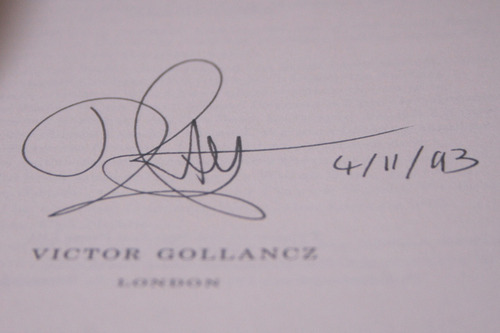
A book signed and dated (in this case prior to publication)
Often one will see signatures pre-dating publication, these are usually where an author has signed a batch of books for a shop prior to publication, but there are some books where the pre-publication date signifies a presentation copy; the books have come from the author’s personal allowance.
Signature Age
As authors age and attend more and more signings it’s not uncommon to see their signatures change, as noted above. The classic example is Terry Pratchett whose signature shifted from a full forename and surname in an attractive scrawl to what is essentially a symbol. We recently handled a collection of signed Pratchett books each of which held a contemporary signature and the progression was quite obvious. The early signatures are scarcer and indicative of a contemporary signing.

A recent Pratchett signature

An early Pratchett signature
Other than scarcity and desirability, one can also use signature ages to determine the authenticity of a signature. A copy of Pratchett’s latest book with an early signature is highly unlikely, and should be viewed as suspicious.
Bookplates
Bookplates come in a variety of forms and from a variety of sources. The least attractive arrangement is when a book is sold with a signature ‘laid in’. Oftentimes the signature will be on a scrap of paper, a publisher’s bookplate or a generic plate. There is no implicit connection between the signed paper and the particular copy of the book. This is simply something that the seller has put together to make the sale more attractive. This particular arrangement can, in our opinion, be worsened when the plate is pasted down by the previous owner.

A publisher’s bookplate (pasted in by the publisher)
Sellers do sometimes sell books and signatures in this format for the legitimate reason that they were purchased in that fashion and therefore the connection between the two is created through the provenance.
There is an exception to this rule when the book is published or sold in that particular state. For example, we have in stock a set of Philip K. Dick’s Collected Stories that were signed by way of a signature strip from a cheque. We also have a Murakami limited edition for which the publisher sent the author a group of plates to sign for the limited edition, which the publishers then pasted in. This is common with limited editions. An edge case is when a bookseller requests a number of plates from the author or publisher and then sells them on. We find that these are generally less preferable.

A book signed by way of a cheque (also a presentation copy)
Finally, bookplates are much easier to forge. There’s no risk of damaging a rare book and mistakes can just be binned. We’ve even seen high-quality photocopies of bookplates.
This is of course a matter of taste, but with regard to collectability one should opt for a book signed directly to the bound page or as published (in the case of tipped in leaves).
Scarcity
The final thing we’re going to look at is scarcity of a book in a signed state. If you find that you have the opportunity to be particular about the manner in which a given book is signed, then the chances are that signed copies are not particularly scarce on the ground. The phenomenon of ‘books with added value’ seems to be fairly recent borne most likely from the Harry Potter craze. Publishers wanted to create the next Harry Potter, collectors wanted to buy the next Harry Potter. The publishers printed first editions in huge quantities because the demand was there. Out of the high demand came a demand for collectable copies. Limited editions (both from the publisher and the bookshop) became more common, but also did books with various additions. By various additions we mean signatures from the cover artist, illustrators, and all manner of people associated with the book, additional sketches, dates under the signature and the recipient’s favourite line from within the book written by the author, ephemera from the publication including posters, bookmarks, postcards, bags and all manner of things. The publishers plough so much into marketing the book that the authors do huge tours where before there might be only a couple of signings. So the first editions are signed in huge numbers and are not rarities.

Signed, with a date and line from the book.
Our recommendation with these type of books is to err on the side of caution. You need to ensure that you’re buying for desirability and not for value because there’s a very good chance that you’ll be overpaying. One also has to understand how much value that embellishment actually adds to the book.
Quality
Byquality I mean the actual standard of the signature. Collectors will often prefer a signature written in a nice pen and not in a hurry. It’s easy to spot a sloppy signature.
Provenance
The stronger provenance you are offered the better chance you have of being secure in your purchase. Provenance doesn’t mean a good story to go with the book, it refers to evidence supporting the book’s reported history.
The important thing to note with provenance is to not be fooled by it. We were recently offered a signed T.S. Eliot book, the book was presented with a letter of provenance. It was a great story, the dates and association all lined up, there were associations with editors of magazines that Eliot wrote for and the names on the inscription all were accounted for – even the date had corroboration. However, the signature felt wrong as did other signatures for that the seller was offering. It was such a complex ruse too that holes appeared. The point is that it was so confidently presented that it was difficult not to believe the provenance.
Limited Editions from the publisher are pretty much guaranteed to be authentic, but are not always more valuable than signed first editions, particularly when printed in runs of 1000 or more. The provenance here is inherent.

A signed limited edition
Things such as ticket stubs, photos of the signing or promotional material can help, but these are not a sure fire way of guaranteeing an authentic signature. Of late, holograms have been used to authenticate a book as holograms are difficult to forge. While this pretty-much guarantees that you’re getting an authentic signature, it also suggests that the book was signed at a mass-signing, which to some extent reduces the desirability.

A hologram
Similarly, a history of the book at auction, doesn’t guarantee authenticity, but it does suggest that someone with a great deal of experience has looked at the signature and deemed it authentic. The same can be said with Certificates of Authenticity. These vary from a hand-written note guarantee to a full-blown holographic certificate from a reputable company. All the latter says is that someone has deemed the signature authentic and perhaps even guarantees that should it be proved inauthentic the buyer will get their money back. The problem is that it’s very difficult to prove a signature inauthentic. Often, experts in the trade will be asked their opinion to examine a purported forgery, which brings me back to my point of asking a member of the trade in the first place.
Another good bit of provenance is catalogue descriptions of the book’s previous sales, or receipts etc. from a previous seller. This chain of sales constitutes a good bit of provenance and again shows that experts have examined the book and deemed it authentic.
Manydealers will help you examine a signature, but the best way to attract these services is by becoming a customer and creating that relationship with the seller. You then have someone you can rely on for help and advice, who in turn can refer to their colleagues in the trade.
The problem with introspection is that it has no end.
Philip K. Dick






